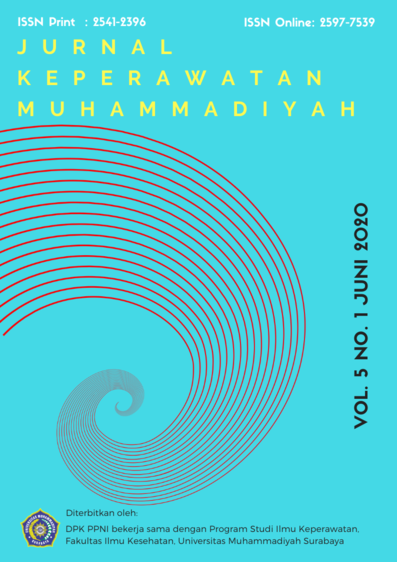Gambaran Pelayanan Kebidanan Komplementer di PMB Kota Surabaya
DOI:
https://doi.org/10.30651/jkm.v5i1.17315Keywords:
Complementary, midwiferyAbstract
Objective: This study aimed to identify complementary midwifery services provided by midwives at the Surabaya City Midwife Independent Practice.
Methods: The research method used in this study is a survey. The population in this study was all patients who were complementary to the samples used were 20 midwives in the IBI area of Surabaya City with sampling techniques using purposive sampling in March 2020. The measuring instrument in this study uses a questionnaire that the researcher himself has made. Data collection in this study was carried out using questionnaires/ questionnaires. The data of the research results were analysed using quantitative descriptive analysis.
Results: The study was conducted on 20 midwives in the IBI area of Surabaya City. All respondents provided massage services to mothers and babies as much as 100%, as many as 18% (13 midwives) provided hypnotherapy services, 21% performed yoga services, 22% provided aromatherapy services and 11% provided acupressure services to pregnant women.
Conclusion: of the 20 respondents, all have performed complementary obstetrics services that are also in demand by consumers.
References
Hall, H. G., McKenna, L. G., & Griffiths, D. L. (2012). Midwifery Care Service With a Complementary Approach Demographic Indonesia Community Needs Fulfillment of Human Resources through Higher Education.
Kostania, G. (2015). Pelaksanaan Pelayanan Kebidanan Komplementer Pada Bidan Praktek Mandiri Di Kabupaten Klaten: Vol. XII (Issue 1).
Permenkes. (2017). Peraturan Menteri Kesehatan Republik Indonesia tentang Pelayanan Kesehatan Tradisional Iintegrasi. Kementrian Kesehatan Indonesia.
Tiran, D. (2003). Implementing complementary therapies into midwifery practice. Complementary Therapies in Nursing and Midwifery, 9(1), 10–13. https://doi.org/10.1016/S1353-6117(02)00133-6
Adams, J. (2006). An exploratory study of complementary and alternative medicine in hospital midwifery: models of care and professional struggle. Complementary Therapies in Clinical Practice, 12(1), 40-47.
Hall, H. G., Griffiths, D. L., & McKenna, L. G. (2012). Complementary and alternative medicine in midwifery practice: managing the conflicts. Complementary Therapies in Clinical Practice, 18(4), 246-251.
Fahimi, F., Hrgovic, I., El-Safadi, S., & Münstedt, K. (2011). Complementary and alternative medicine in obstetrics: a survey from Iran. Archives of gynecology and obstetrics, 284(2), 361-364.
Mollart, L., Skinner, V., Adams, J., & Foureur, M. (2018). Midwives’ personal use of complementary and alternative medicine (CAM) influences their recommendations to women experiencing a post-date pregnancy. Women and Birth, 31(1), 44-51.
Kusuma, I. R. (2018). Asuhan Kebidanan Komplementer Pada Perawatan Bayi Baru Lahir (Studi Kualitatif) Complementary Cares on Midwifery in new baby born (Qualitative Study) Jurnal Kesehatan Al-Irsyad (JKA), Vol. Jurnal Kesehatan Al-Irsyad (JKA), 11(1).
Downloads
Published
Issue
Section
License
- Penulis tetap memegang hak atas karyanya dan memberikan hak publikasi pertama kepada jurnal ini yang secara simultan karya tersebut dilisensikan di bawah:Â Creative Commons Attribution-ShareAlike 4.0 International (CC BY-SA 4.0)













